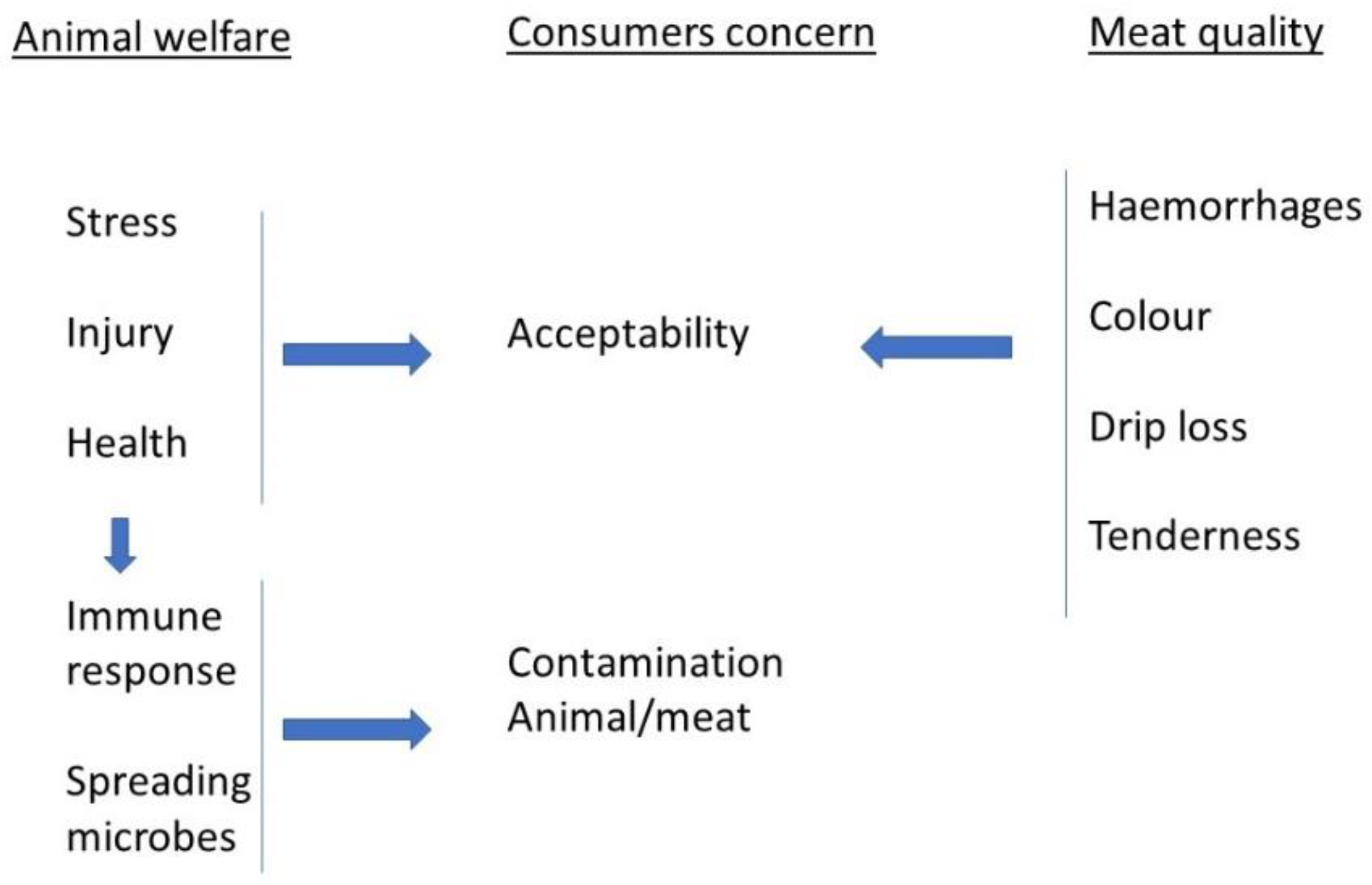Animal Stress and Welfare During Transport and Slaughtering: An Outline for Future Policies
1. Introduction
2. Welfare and Stress
3. Transport
4. Lairage
5. Stunning
6. Recommendations for Developments
Funding
Conflicts of Interest
References
- van Reenen, K.; Reimert, H.; Gerritzen, M.; Leenstra, F.; Lambooij, B. Hazard Identification and Characterization of Welfare Aspects During Transport of Farm Animals; Report 152; Animal Science Group: Wageningen, The Netherlands, 2008; Available online: http://edepot.wur.nl/121065 (accessed on 16 October 2024).
- EFSA (European Food and Safety Authority). Welfare aspects of the main stunning and killing the main commercial species of animals. EFSA J. 2004, 45, 1–29. [Google Scholar]
- Terlouw, C.; Bourguet, C. Quantifying animal welfare preslaughter using behavioural, physiological and carcass and meat quality measures. In Preslaughter Handling and Slaughter of Meat Animals; Faucitano, L., Ed.; Wageningen Academic Publication: Wageningen, The Netherlands, 2022; pp. 13–61. [Google Scholar]
- World Organisation for Animal Health (OIE). Terrestrial Animal Health Code; WOAH: Paris, France, 2019; pp. 333–336. [Google Scholar]
- Brambell, R. Report of the Technical Committee to Enquire into the Welfare of Animals Kept Under Intensive Livestock Husbandry Systems; H.M. Stationery Office: London, UK, 1965; 84p. [Google Scholar]
- EFSA (European Food and Safety Authority). Animal Consciousness; EFSA Supporting Publications: Parma, Italy, 2017; Volume 14, pp. 1–165. [Google Scholar]
- Faucitano, L.; Ribas, J.; Lambooij, E. Transport of pigs. In Livestock Transport and Handling, 6th ed.; Grandin, T.A., Ed.; CABI Publishing: Wallingford, UK, 2024; in press. [Google Scholar]
- Blokhuis, H.J.; Miele, M.; Veissier, I.; Jones, B. Improving Farm Animal Welfare; Wageningen Academic Publication: Wageningen, The Netherlands, 2013; 232p. [Google Scholar]
- Algers, B.; Anil, H.; Blokhuis, H.; Fuchs, K.; Hultgren, J.; Lambooij, B.; Nunes, T.; Paulsen, P.; Smulders, F. Project to Develop Animal Welfare Risk Assessment Guidelines on Stunning and Killing; (Question No EFSA-Q-2007-168) project ID CFP/EFSA/AHAW/2007/01; EFSA Supporting Publications: Parma, Italy, 2009. [Google Scholar]
- Atkinson, S. Assessment of Cattle and Pig Welfare at Stunning in Commercial Abattoirs. Ph.D Thesis, Swedish University of Agricultural Sciences: Uppsala, Switzerland, 2016. [Google Scholar]
- Broom, D.M.; Johnson, K.G. Stress and Animal Welfare; Chapman and Hall: London, UK, 1993. [Google Scholar]
- Orzechowski, K. Global Animal Slaughter Statistics and Charts; Faunalytics Organization: San Diego, LA, USA, 2024. [Google Scholar]
- Kevany, S. Animals Farmed, Animal Welfare; The Gardian.org: Manchester, UK, 15 June 2022. [Google Scholar]
- Valkova, L.; Vecerek, V.; Voslarova, E.; Kaluza, M.; Takacova, D.; Brscic, M. Animal welfare during transport: Comparison of mortality during transport from farm to slaughter of different animal species and categories in the Czech Republic. Ital. J. Anim. Sci. 2022, 212, 914–923. [Google Scholar] [CrossRef]
- Lambooij, E.; Puister-Jansen, L.; Graven, W.; Bemelman, Y. Haalbaarheid Mobiel Slachthuis en Uitsnijderij; Livestock Research report 460; Wageningen UR Livestock Research: Lelystad, The Nederland, 2011. [Google Scholar]
- Hultgren, J. Avoiding live-animal transport to slaughter: Mobile abattoirs. In Preslaughter Handling and Slaughter of Meat Animals; Faucitano, L., Ed.; Wageningen Academic Publication: Wageningen, The Netherlands, 2022; pp. 390–434. [Google Scholar]
- EFSA (European Food and Safety Authority). Welfare of pigs at slaughter. EFSA J. 2020, 18, 6148. [Google Scholar]
- EFSA (European Food and Safety Authority). Welfare of cattle at slaughter. EFSA J. 2020, 18, 6275. [Google Scholar]
- Temple, G. Practical methods to improve animal handling and restraint. In Animal Welfare and Slaughter; Velarde, A., Raj, M., Eds.; 5M Publishing Ltd.: Sheffield, UK, 2016; pp. 71–90. [Google Scholar]
- Blackmore, D.K.; Delaney, M.W. Slaughter of Stock; Publ. No. 118. Vet. Con. Ed.; Massey University: Palmerston North, New Zealand, 1988. [Google Scholar]
- Villarroel, M.; Lambooij, E. Fish. In Preslaughter Handling and Slaughter of Meat Animals; Faucitano, L., Ed.; Wageningen Academic Publication: Wageningen, The Netherlands, 2022; pp. 118–150. [Google Scholar]
- Schomer, D.L.; Lopes da Silva, F.H. Niedermeyer’s Electroencephalography Basic Principles, Clinical Applications and Related Fields; Wolters Kluwer: Philadelphia, PA, USA, 2012; 1296p. [Google Scholar]
- EFSA (European Food and Safety Authority). Scientific opinion on monitoring procedures at slaughterhouses for pigs. EFSA J. 2013, 11, 3523. [Google Scholar]
- AVMA. Guidelines for the Humane Slaughter of Animals: 2024 Edition; American Veterinary Medical Association: Schaumburg, IL, USA, 2024. [Google Scholar]
- AVMA. Guidelines for the Euthanasia of Animals: 2020 Edition; American Veterinary Medical Association: Schaumburg, IL, USA, 2020. [Google Scholar]

Disclaimer/Publisher’s Note: The statements, opinions and data contained in all publications are solely those of the individual author(s) and contributor(s) and not of MDPI and/or the editor(s). MDPI and/or the editor(s) disclaim responsibility for any injury to people or property resulting from any ideas, methods, instructions or products referred to in the content. |
© 2024 by the author. Licensee MDPI, Basel, Switzerland. This article is an open access article distributed under the terms and conditions of the Creative Commons Attribution (CC BY) license (https://creativecommons.org/licenses/by/4.0/).
Share and Cite
Lambooij, E. Animal Stress and Welfare During Transport and Slaughtering: An Outline for Future Policies. Animals 2024, 14, 3064. https://doi.org/10.3390/ani14213064
Lambooij E. Animal Stress and Welfare During Transport and Slaughtering: An Outline for Future Policies. Animals. 2024; 14(21):3064. https://doi.org/10.3390/ani14213064
Chicago/Turabian StyleLambooij, Elbert. 2024. "Animal Stress and Welfare During Transport and Slaughtering: An Outline for Future Policies" Animals 14, no. 21: 3064. https://doi.org/10.3390/ani14213064
APA StyleLambooij, E. (2024). Animal Stress and Welfare During Transport and Slaughtering: An Outline for Future Policies. Animals, 14(21), 3064. https://doi.org/10.3390/ani14213064



